How to get rid of a tree stump?
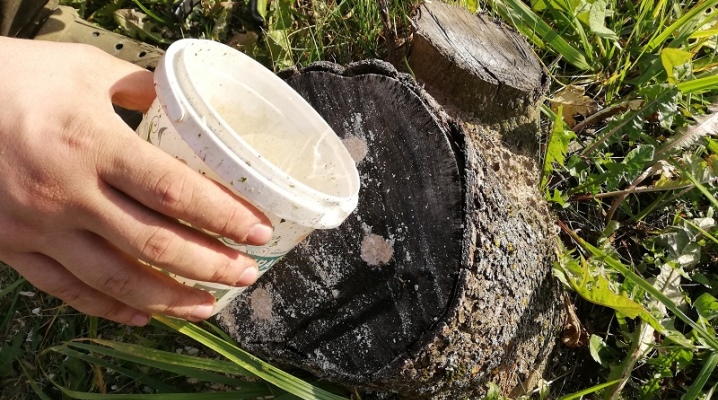
Sometimes the remains of a felled tree can become a problem when organizing planting of garden and horticultural crops. And there is also a risk that harmful microorganisms that have settled in the stump and destroy it will eventually spread to the grown plants.

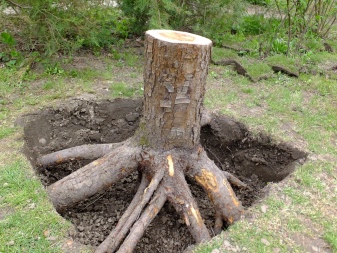
How to remove by uprooting?
To level the landscape and plant useful plants on the site, in some cases it is necessary to remove wild or barren trees and eradicate their remains. A variety of methods will help you get rid of the stump. However, in this case, you need to act so as not to make the soil useless and not spoil the plantings in the garden. The easiest and fastest way is to manually remove the stump, which will require tools that are often used in everyday life: an ax and a long metal stick or crowbar. You need to dig a depression at a distance of about 1 m from the base of the stump and open the roots, which are then chopped off with an ax. After that, using the crowbar as a lever, the tool is lifted with effort. With the help of a crowbar, even deeply growing roots can be pulled out. The disadvantage of this method of uprooting is wood residues in the layers of the earth, which interfere with the leveling of the terrain for construction.
Using a hand winch is another simple but physically demanding way to clear an area. To remove the roots, the stump is dug in along the radius at a distance of one and a half meters until the roots are exposed. Then the winch cable is threaded under the root and gradually pulled out of the ground. The method is laborious and does not always give the desired result. The use of special technical equipment to clean the area is not always an acceptable option. In some cases, it is quite difficult to ensure the passage of a special machine (tractor) to the workplace. Roots from an old stump often grow into the lower soil layers, as a result of which they are difficult to uproot with the help of technology. Removing wood residues using a tractor with a winch is recommended if a new site is being cleared with several stumps that need to be removed.
Large-sized old stumps can be disposed of by crushing or burning them. Crushing with the help of special machines (crushers) is used when it is not possible to fit the tractor. The advantage of the method for removing stumps by crushing is the ability to eliminate large butts and the speed of the process. The crusher can be adjusted to the parameters required for the work carried out independently. As a result of the use of crushing equipment, small wood waste remains from a large stump, which can be dug up with the ground. The disadvantage of this method is that it is impossible to dig up the stump and divide it into small parts without first removing the roots. Mushrooms can be grown on the remains of the tree, which after a few years will lead to its destruction.
If the owner of the site has skillful hands and design skills, then he will be able to turn old stumps into exclusive and interesting details of landscape design. They can be used to make tables, seats, stands for garden gnomes, and so on.


Step-by-step burning method
In order to exclude the risk of an underground fire, it is not allowed to burn the remains of felled trees in the ground on peat soils. To quickly burn out a stump, you need to drill a few lye on it, pour fuel into it and set it on fire.
In order to avoid mistakes for the correct burning of the remains of felled trees, you need to follow the step-by-step instructions.
- A hole is formed in the middle of the stump, the diameter of which is about 20 mm.
- Another slot is drilled on the side, connecting it to the central one. The side slit facilitates the supply of oxygen to the combustion area. There can be several such holes.
- Pour 200 ml of any rapidly flammable liquid into the slot. You can use a liquid designed for charcoal ignition.
- A wick is made of natural matter, which, after moistening with a special liquid, is placed in the upper slot and set on fire.
If the first attempt to burn out wood residues was unsuccessful, you need to place sawdust on top, then repeat the process again. Burning out will help turn even a rather large stump into dust in a short time.
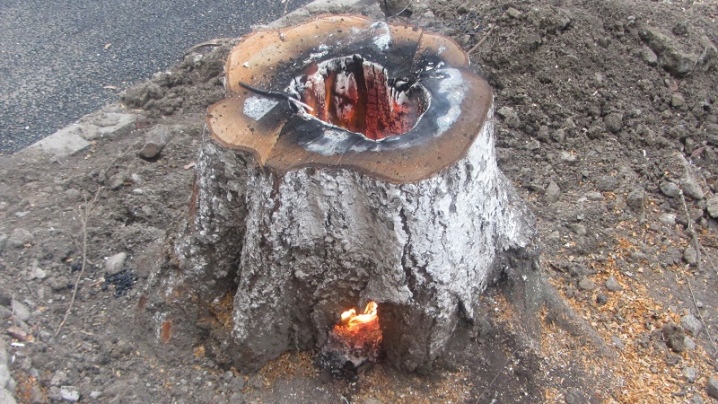
Removal by water
Stump washing can be done provided you have your own water source and a powerful pump capable of providing good fluid pressure in the hose. If there are areas with cultivated plants close to the butts, for which excessive moisture is dangerous, it is recommended not to risk it.
If the construction of buildings on this territory is planned only after a year, you can make a lot of holes in the cut and during the period of severe frosts pour abundantly the rest of the felled tree with water. The liquid will expose the wood to internal erosion, and after 3-4 months the stump will be easily eradicated.

How to destroy a tree stump with chemicals?
Chemical removal of the residue from a sawn tree is one of the fairly common and effective methods. The method is based on the reactions occurring in plant cells under the influence of the used reagent. Chemicals destroy even large roots and also destroy pathogens. After destruction, dead wood must be burned or eradicated. Reagents can adversely affect the quality and composition of the soil in the garden area, and therefore it is necessary to choose a specific method of chemical destruction taking into account the possible consequences, especially if the area to be cleaned in the country is planned to be used in the future for planting cultivated plants, and not for construction.
Chemical action is also used to treat wood residues in order to destroy pathogenic agents of diseases, when it is necessary not only to remove wood pulp, but also to prevent the growth and spread of root residues. Using correctly selected preparations, you can completely destroy the entire root system with your own hands in a short time and stop its further growth. Thus, chemical treatment is necessary in order for the root to rot.
Chemical eradication is the recommended method for eliminating disease-infested roots, as there is a risk that pathogens can easily spread to healthy plants through contaminated soil. Chemical uprooting is effective against wild trees growing on the territory of construction sites and ready-made buildings. As a rule, uncultivated trees are quite tenacious, and after removing their roots, part of the root system at a depth continues to function and grow. Chemicals can kill even the most hard-to-reach roots, allowing the site to be used for the desired purposes.
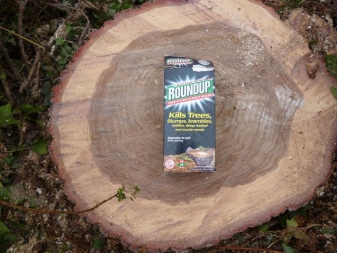
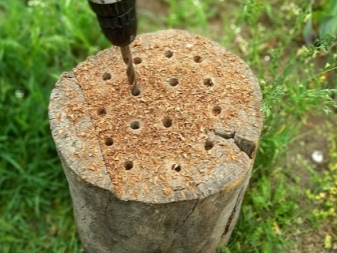
It is important to know that chemical processing is not a safe way. After all, aggressive elements get into the ground, which negatively affect many plants.
For example, certain apple species are very sensitive to chemicals, and chemical treatment of dead wood carried out nearby can dramatically reduce the fruitfulness of the tree and even cause its death.
The technique for applying chemicals is the same. Slits are made about 15 mm in diameter, which must be vertically open and evenly distributed.If the tree has been broken, you need to make holes in the trunk, placing slots around the entire perimeter. The gaps between the slots should be 5-10 cm. For external drilling, the tool should be directed at an approximately 40-degree angle so that the filled substance is kept inside.
The finished holes should be filled up to the top with the selected reagent, then poured with water to accelerate the reaction and settle the particles of the substance. After the hole is closed with a stopper made of wood or clay material (you can use plasticine). Decomposition of wood begins under the influence of the chemical. Complete destruction of a dead tree, regardless of its size, requires a maximum of 2 years. During this period, the remnants rot, leaving a cleaned area that can be used for any purpose.

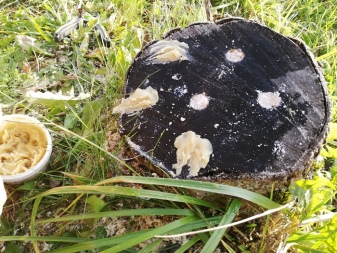
Table salt
This method is pretty easy to use. In about 60 days, salt can completely eliminate any microorganisms and stop the vegetative activity of the root system. If the area around the treated tree is planned to be filled with a concrete mass, after dying off the remnants of the wood and roots are burned. In other cases, they should be eradicated, since excess salt will make the soil sterile, and the iron structures mounted next to it will quickly begin to rust.
It is recommended to sprinkle large amounts of coarse salt immediately after the saw cut and add after each rain. Salted wood turns into dust.
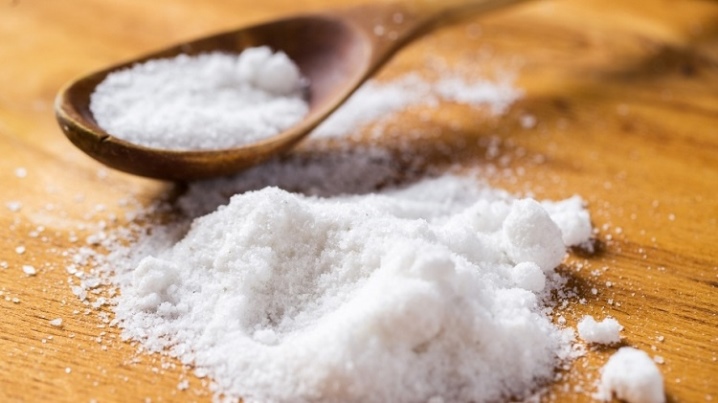
Copper or iron sulfate
Substances are highly toxic and capable of killing all types of pathogenic bacteria living in wood. These reagents are also used to disinfect the roots of infected trees. The preparations are introduced by the method described above, making holes with a diameter of 8 mm and a depth of up to 10 cm. It is impossible to treat a stump next to metal pipes with these reagents, since substances can accelerate the corrosion process.
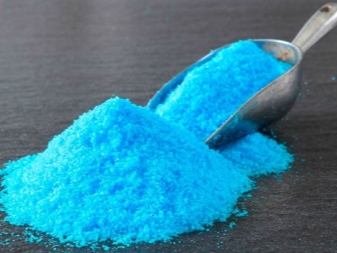
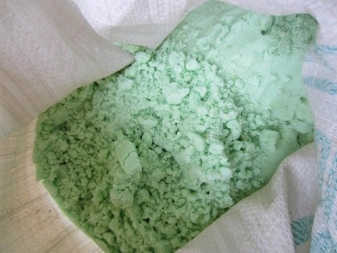
Herbicides
The most effective way to kill a tree stump is to use a urea or saltpeter herbicide. Substances are used according to the above scheme. Urea is used as a soil fertilizer and for pest control. Its impact cannot lead to a decrease in soil quality. Burning out wood debris with potassium nitrate is another common way to destroy wood debris. Saltpeter burns well, in order to speed up grubbing with a chemical method, you need to wait a while until the tree is saturated with the substance, and then burn out the stump. In this case, you cannot stand close to the fire. Saltpeter can be used to free the site from hemp if the site is planned to be used for construction in the future. For a long time after chemical treatment, only unpretentious ornamental plants can grow in this area.
All types of reagents are advised to be applied at the end of autumn, as autumn rains can wash away the chemicals and neutralize their effect. When working with chemicals, you must observe safety measures. Do not smoke during chemical processing. Up to 3 months after the laying of saltpeter, processes occur in the wood, accompanied by the release of combustible gases. Smoking near reagent-treated stumps can cause a fire.
It is forbidden to stand on the leeward side of the burning wood residue, as wood soaked with herbicides releases highly toxic substances when ignited.
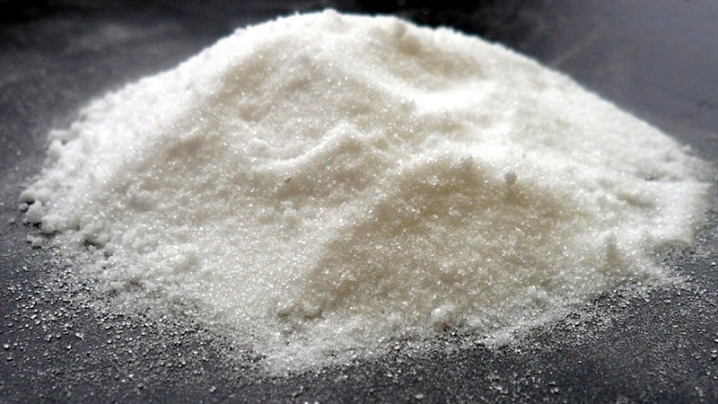
For how to easily get rid of an unnecessary stump in two minutes, see the next video.
































































The comment was sent successfully.